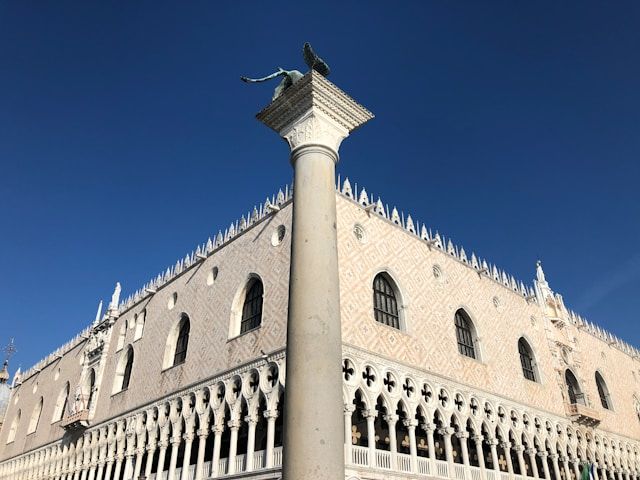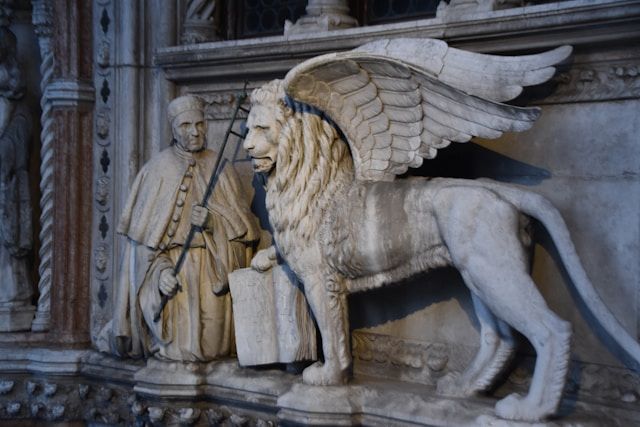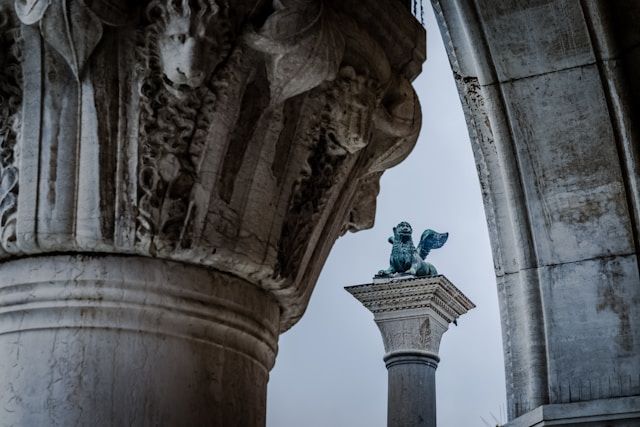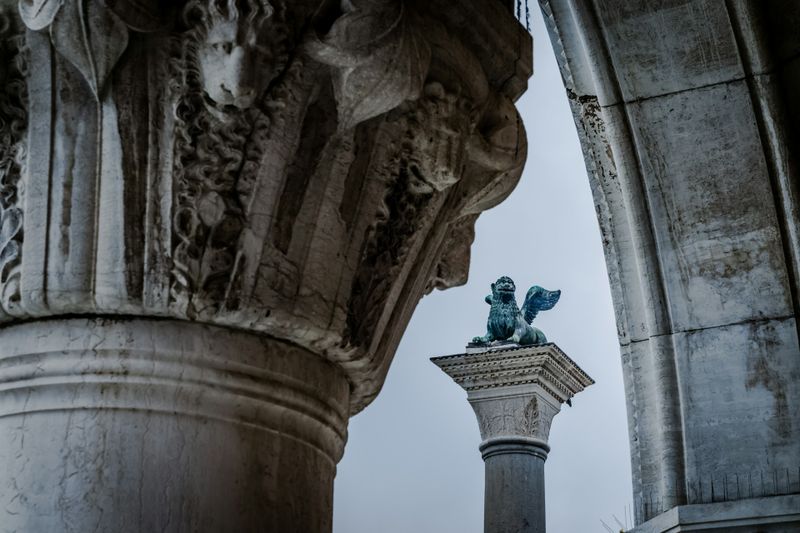Few symbols are as famous as the winged lion of Venice. This magnificent creature is part of Venetian culture and history and is everywhere in Venice and beyond. But what makes the winged lion so special and why is it so important to the city?
In this post we will get to the bottom of the mystery and meaning of the winged lion, its origins and where you can find its many depictions in Venice.
Whether you’re a tourist, history lover or just curious about one of the most amazing symbols of Italy, this story of the winged lion of Venice will enchant you.
Winged Lion of Venice: A symbol with meaning

One of the most fascinating things about Venice is its link to St. Mark. The winged lion is not just any lion – it is the winged lion of St. Mark, Venice’s patron saint.
From ancient times Venice adopted this creature as a symbol of power, strength and religious importance. As St. Mark is believed to be the author of one of the four gospels in the Bible his connection to the winged lion goes back to Biblical times.
What does the Winged Lion of Venice mean?

The winged lion of Venice means more than just a link to the city’s patron saint. It means the intertwining of Venetian political power, religious authority and maritime dominance. Throughout history the Venetian lion has been a symbol of power and influence, its wings representing the city’s control of the Mediterranean.
But beyond the venetian republic the winged lion is also a symbol of peace and protection. The Latin phrase “Pax Tibi Marce Evangelista Meus” (meaning “Peace be upon you, O Mark, my Evangelist”) is often written on the lion’s open book, confirming St. Mark’s role as the bringer of peace to the Venetian territory.
Where is the Winged Lion of Venice?
As you walk through the streets of Venice you can’t miss the winged lion. One of the most famous depictions of the winged lion is in Piazza San Marco where the standing winged lion looks down from its high pedestal. Here the lion is a grand reminder of the venetian republic’s power and influence in its heyday.
Mark’s Square is not the only place to find this iconic figure. The bronze statue of the winged lion is on top of the columns near the Doge’s Palace, watching over the city. Another beautiful sculpture is the bronze lion at the entrance of the Arsenal, the historic heart of Venice’s naval power.
Winged Lion of St. Mark meaning
The winged lion has a strong link to St. Mark, the patron saint of Venice but its meaning goes much deeper.
According to venetian tradition when two merchants from Venetian lands found the remains of Saint Mark in Egypt they brought them back to Venice. It is said that during a stormy sea voyage an angel appeared to calm the waters and guide the ship to safety and thus the lion is connected to protection and divine intervention.
The winged lion is a religious symbol but also a political one. The four winged creatures in the Book of Revelation are often interpreted as the four evangelists and the lion is the symbol of St. Mark because Mark describes Jesus Christ as the “lion of Judah”.
Over time this biblical imagery became part of the venetian tradition and St. Mark as the protector and guide of the city.
Winged Lion of St. Mark Venice
The story of the winged lion of Venice starts in the Bible but its emergence as the main symbol of Venice was a process. Early records show that Saint Theodore, a military saint, was the patron saint of the venetian territories. But as the importance of maritime power grew so did the role of St. Mark and his winged lion.
The shift towards the lion of St. Mark representing Venice happened when the venetian leaders wanted to differentiate the city from other European powers especially after the arrival of Mark’s relics in the city. Over time the venetian lion became the symbol of the unique combination of religious devotion and venetian balanced power.
Lion of St. Mark Venice history
The lion of St. Mark has a long history in Venice. From its ancient origins as the symbol of the city’s patron saint the standing winged lion has survived centuries of political and religious changes. During the height of the venetian republic the bronze statue of the winged lion was the symbol of the venetian tradition states.
After Napoleon’s conquest of Venice in 1797 the original bronze statue of the winged lion was taken down and sent to Place des Invalides in Paris as a spoil of war. But after Napoleon’s fall the lion was brought back to Venice, badly damaged and eventually restored to its original place in Piazza San Marco.
The Winged Lion During World War II
Even during the chaos of World War II the winged lion continued to be the symbol of venetian resilience. As Venice was dealing with the aftermath of the Austrian Empire’s collapse and the rise of fascism in Italy the lion was the symbol of hope and continuity.
During the war venetian lions were on the sleeve insignia of the Italian soldiers, representing the city’s unbroken spirit as they fought alongside other Italian troops.
The Winged Lion Today: Venice Film Festival
Today the winged lion of Venice continues to inspire and attract. A modern version of this ancient symbol is at the Venice Film Festival where the golden lion is one of the most coveted award in the world of cinema.
While the bronze lion in piazza san marco is rooted in tradition the golden lion at the festival represents Venice’s ongoing influence and cultural relevance in Italy and beyond.
Winged Lions and St. Mark’s legacy
The winged lions of Venice are more than just decorations; they are the history, faith and resilience of this city.
The lion is the proud symbol of St. Mark, reminding locals and tourists of the city’s rich history and unbroken spirit. St. Mark’s Gospel lives in every sculpture and the legacy of the winged lion of Venice is at the heart of venetian identity.
Is the Winged Lion of San Marco of Venice from China?

Recent research has revealed a surprising twist in the story of the winged lion of Venice. For centuries the bronze on top of the Colonna di San Marco has been considered the winged lion of St. Mark, the symbol of Venice’s maritime power and its patron saint.
But two professors from the University of Padua have challenged this long held belief. According to isotopic and archaeological analysis this iconic statue may not be a lion at all – but a Chinese Zhènmùshòu, a mythical creature that guarded royal tombs during the Tang dynasty.
This theory proposed by archaeologist Massimo Vidale and geologist Gilberto Artioli suggests that the bronze statue was made in China between the 8th and 9th centuries before it arrived in Venice. Using advanced isotopic analysis the researchers traced the origin of the copper used in the bronze to the lower Yangtze River basin in China which supports the Asian provenance.
Moreover the statue’s features – the prominent nose, open mouth with sharp canines and what appear to be horns – are typical of the Zhènmùshòu and not a traditional lion.
So this opens up a new scenario: could the statue have been brought to Venice by the Polo family as the father and uncle of Marco Polo traveled through China in the 13th century?
It’s still speculation but this theory sheds a new light on how venetian culture blended with eastern influences and how the city can adopt and transform foreign objects and symbols to fit its own history and identity.
Winged lion Venice: conclusion
In the end the winged lion is not just about ancient symbols or religious devotion. It’s about the ongoing story of a city that has survived wars, conquests and time and is still shining as a cultural and historical beacon.
As you walk through the streets of Venice look up at the winged lion above mark’s square and all around the city. Each one tells a story – the story of peace, power and a lasting legacy.

